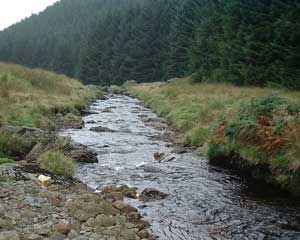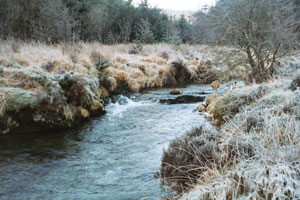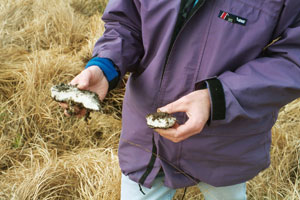Acidification



Background
It was estimated in 2002 (Scoping study for Acid Waters in Wales, Ormerod et al) that some 17% (62kms of main stem and tributaries) of the Upper Wye and Irfon system were suffering from the effects of acidification. Fortunately the Usk catchment lies outside the affected geology. For comparison, other welsh rivers affected include the Tywi (39km), Conwy (8.4km) and Glaslyn (5km).
Acidification, the result of acid rain falling in areas of poorly buffered substrates, is made worse where commercial forestry is the dominant land use. It adversely affects all aquatic organisms from diatoms (simple two celled algae) to fish. These streams are characterised by having extremely low pH 'events' following rainfall. In appearance, these streams often appear to be 'crystal' clear and inspection will reveal an impoverished invertebrate colonisation - just look under the stones.
Further exacerbating the problem is the deep and effective drainage within commercial forestry which results in the removal of any water holding capacity, along with the needles of coniferous trees attract an occult precipitation of acidity. The result: flashy flows with marked drop in pH during rainfall events often with high levels of dissolved aluminium, a cocktail of disaster for invertebrate and fish life. Fortunately, the physical structure of many of these streams remain largely undamaged as provided they are in a wide, treeless corridor they are free from the overgrazing that blights other sections. In the Wye, the large, early running springers spawned in many of the streams now affected and so there is ample incentive to find an effective treatment.
What can be done?
Projects to correct the problem have met with varying degrees of success, including mechanical lime dosing schemes on the Twyi and Hafren. The former project was carried out above the impoundment of Llyn Brianne on the Tywi which provides a suitable buffering and mixing site. With no physical access above the dam for fish, there was no requirement for treatment of the smaller order streams. However, restoring such streams was crucial to the needs of our Wye restoration scheme.
Professor Steve Ormerod and colleagues published a long-term survey of work previously carried out in the 80s. When acidification first appeared, he conducted a series of controlled (BACI) experiments to determine what would be effective way of curing the problem. A review of this work in 2002 demonstrated that liming the actual hydrological source of a stream (the uppermost area from which streams arises) not only provided the right neutralising effect, but also that the benefit lasts for substantially more than a decade. Additionally, the 'cure' was effective over the entire stream. This technique is termed 'Hydrological Source Liming' and formed the basis for our pHish project.
